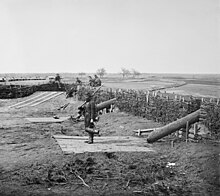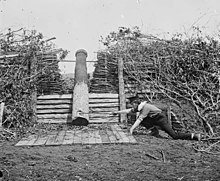Quaker gun


A Quaker Gun is a deception tactic that was commonly used in warfare during the 18th and 19th centuries. Although resembling an actual cannon, the Quaker Gun was simply a wooden log, usually painted black, used to deceive an enemy. Misleading the enemy as to the strength of an emplacement was an effective delaying tactic. The name derives from the Religious Society of Friends or "Quakers", who have traditionally held a religious opposition to war and violence in the Peace Testimony.
The original "Quaker Gun trick"
During the American War of Independence, after nearly a year of brutal backcountry conflict between American Colonel William Washington and the fierce British commander Lieutenant Colonel Banastre Tarleton, Colonel Washington had retreated to North Carolina in October 1780.[citation needed]
Ordered to leave a regular force of colonial dragoons in the North Carolina theater by Brigadier General Daniel Morgan, Colonel Washington still lacked the proper artillery to dislodge the Loyalists. On December 4, the Americans were able to trap the Loyalist Colonel Rowland Rugeley and his force of about 125 men in Rugeley’s house and barn near Camden, South Carolina. He told his cavalrymen to dismount and surround the barn. Out of Rugeley’s sight, Washington’s men prepared a pine log to resemble a cannon.[1]
The "Quaker Gun Trick" worked quite well. Colonel Washington aimed the wooden "cannon" toward the buildings the Loyalists had barricaded themselves in and threatened to open fire if they did not immediately surrender. Rugeley surrendered quickly his entire force without a single shot having been fired.[1]
Use during the American Civil War

Quaker guns were used by both the North and South in the American Civil War. The Confederate States Army frequently resorted to them because of its shortage of artillery. The wooden guns were painted black and positioned in fortifications to delay Union assaults. Sometimes actual gun carriages were used in the deception.[2]
The most famous use of a Quaker gun was by Confederate General Joseph E. Johnston, who placed them in his field works around Centreville, Virginia in March 1862, to give the appearance that the works were still occupied, while his men were actually withdrawing to the Rappahannock River.[citation needed]
Another example happened during the Siege of Corinth. "During the night of May 29, the Confederate army moved out. They used the Mobile and Ohio Railroad to carry the sick and wounded, the heavy artillery, and tons of supplies. When a train arrived, the troops cheered as though reinforcements were arriving. They set up dummy Quaker Guns along the defensive earthworks. Camp fires were kept burning, and buglers and drummers played. The rest of the men slipped away undetected..."[citation needed]
Quaker Guns were also used to bolster Confederate fortifications during the Siege of Petersburg and assisted in prolonging the Confederate's hold on their positions against the overwhelmingly superior numbers of Union troops.[citation needed]
Use during World War II
A similar idea was employed during the Doolittle Raid, which occurred in the early stages of the Pacific War of World War II, where Lieutenant Colonel Jimmy Doolittle led a squadron of B-25 Mitchells to bomb Tokyo. The early model B-25B had no guns installed in the tail section to help protect the planes from tail-end attacks. While modifying the bombers for the mission at Eglin Field, Florida, Doolittle had fake machine guns consisting of a pair of broomsticks painted black mounted at the tail end of the fuselage to simulate tail guns.[3]
Similarly, while preparing for the coming invasion of France, the German forces on Pointe du Hoc moved their artillery battery and replaced it with upturned logs and barrels in order to fool the invading Allied forces.[citation needed] Dummy equipment was also used extensively by the Allies in Operation Fortitude, to persuade the Germans that a non-existent field army was preparing to attack Calais.
The pre–World War I British battleship HMS Centurion was obsolete and disarmed by World War II. However, from 1942 to 1944, she was fitted with wooden guns and stationed in the eastern Mediterranean, to make British naval forces in the area seem stronger than they were.[citation needed]
Wooden cannon
Unlike a Quaker gun, a wooden cannon is a functional weapon, albeit notoriously weak and only able to fire a few shots, sometimes even just one shot, before bursting. These were used by those without access to metal or the skill to engineer metallic cannons.[4]
See also
Notes
- ^ a b "December of 1780". National Park Service. Retrieved January 7, 2009.
- ^ "Definitions of Civil War terms". Shotgun's Home of the American Civil War. Retrieved January 7, 2009.
- ^ I Could Never Be So Lucky Again, by General James H. "Jimmy" Doolittle, with Carrol V. Glines, p. 228 (Bantum paperback edition, 1991).
- ^ W. Y. Carman (2004). A History of Firearms. Dover Publications. p. 64.
Further reading
- Ripley, Warren (1984). "Artillery and Ammunition of the Civil War". Charleston, S.C.: The Battery Press.
{{cite journal}}: Cite journal requires|journal=(help). - Latimer, Jon (2001), Deception in War, pp. 26–9. London: John Murray. ISBN 0-7195-5605-8.
